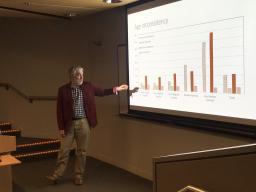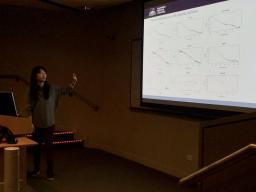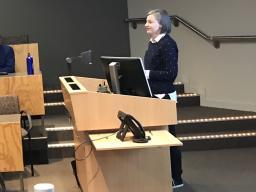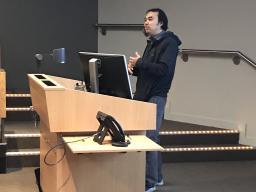2019 School of Demography Work in Progress Day presenters (from left Ayumi Malamassam, Meg Kingsley, Muhammad Ulil Absor, Qing Guan, Tim Carlton, Mengxue Chen, Ester Lazzari)
The 2019 PhD Work in Progress (WIP) Day for PhD students in the ANU School of Demography was held on Thursday 5 September.
Work in Progress Day allows our graduate students to practice their research presentation skills in a supportive and collaborative environoment, thus preparing them to present during seminars and international conferences.
Students gave short presentations on their research and received feedback from academics in the audience. Our PhD cohort organised the event and chaired sessions.
Why people are increasingly identifying as Indigenous (Tim Carlton)
With changing propensity to identify as Indigenous being a major driver of Indigenous population growth, it is important to understand the dynamics behind this phenomenon. Contrary to previous research in this field, and international experience, Australia has not experienced large countervailing gross flows: People are changing from non-Indigenous to Indigenous, with relatively few people changing in the other direction. The newly identifying are not concentrated in younger age groups, but are evenly distributed across all age groups. I examine a range of theories about why people are changing how they identify, but am struggling to find a theory that fits the data.
Geographic access and potential need for assisted reproductive technology (ART) health care in New South Wales, Australia (Ester Lazzari)
The aim of this study is to describe the geographic distribution of assisted reproductive technology (ART) services and to quantify the prevalence of women at risk of experiencing infertility with limited geographic access to fertility care. ArcGIS Network Analyst extension is used to find 30 and 60-kilometers service areas around each ART clinic and to identify the population potentially in need for treatment living outside of the service areas’ boundaries. High educational attainment and late reproductive age are used as predictors for need for infertility treatment, as the demand for ART in developed countries is mainly driven by highly educated women of over 35 years of age. Taking the State of New South Wales (NSW) as a case study, this analysis shows that potential need for and the current accessibility to fertility services vary considerably across space. In 2016, 36 percent of reproductive age women and 29 percent of late reproductive age women with high educational attainment had limited geographic access to ART clinics. These findings are believed to be important to understand disparities in utilization and success rates, as infertile couples that do not live in proximity of an ART clinic are less likely to seek care, and more likely to drop out of infertility treatment before achieving a pregnancy.
Spatial structure of youth migration in Indonesia: Does educational selectivity matter? (Ayumi Malamassam)
It is broadly understood that migration works in a selective nature, particularly by age and education. The spatial movements of young population have been a significant part of migration flows due to life-cycle events related to their transition to adulthood. Meanwhile, education has also been suggested to have a positive impact on migration propensity. It is argued that different regional opportunities will work differently toward well- and less-educated migrants. This situation can result in education-selective migration patterns. Thus, by using the multiplicative component method to analyse data from the 2000 and 2010 Indonesia Population Census, this study examines the spatial interaction model of youth migration flow by highlighting the migrants’ educational attainment. The preliminary findings show that, over the years, migration flow in Indonesia is geographically unbalanced toward regions with more advanced levels of development and mostly concentrated in Java Island – the most developed island in the country. However, some rural regions experienced noticeable increasing proportions of gaining young migrants with high education level. In addition, Jakarta - the country’s capital city - has high ratios of losing highly educated migrants and gaining low-educated migrants. The findings also indicated that the interaction between education and migration may vary considerably across regions.
Measuring the urban-rural health inequality in China --- how much does the population structure matter? (Mengxue Chen)
The past decades have witnessed China’s rapid socioeconomic development and an overall increase in life expectancy. Previous research suggests that the health inequality situation in China has improved too, with the observation that the gap between life expectancy in the urban and rural population is gradually shrinking. However, not many studies have discerned how much of this change in health inequality was a result of health improvement and how much is caused by the difference in population composition. This study examines the health inequality level of urban and rural population in China with life disparity - e † (an indicator covers all ages and has important implication in public health), then use the decomposition method to discern the impact of direct and compositional change, and look into the differences in urban/rural health inequality brought by the different causes of death.
Different dimensions of immigrant integration and how they interrelated (Qing Guan)
A theoretical expectation shared by assimilation and integration theories is that different dimensions of immigrants’ incorporation into the destination society are functionally related. Thus, immigrant’s acculturation and language competency are associated with upward social mobility, residential choices are associated with socioeconomic status, and political participation is associated with national identification. An alternative expectation, however, is that the multidimensional concept and measurement of integration help to explain partial incorporation. For instance, there are persons build successful careers without learning language and culture, and persons who are politically active yet socioeconomically excluded from the host society. This research aims to explore the multidimensional feature of immigrant integration in the destination country and examine the two expectations with Australian data. Relying on Census microdata and Continuous Survey of Australia Migrants, I will build a structural equation model to investigate the associations between spatial dimension, socioeconomic dimension, cultural dimension, and political/civil dimension of immigrant integration. The results will potentially contribute to a better understanding of different dimensions of immigrant integration and how they interrelated.
Parents’ work-family conflict and children’s socio-emotional development: Exploring differences by financial hardship in Australian dual earner families (Meg Kingsley)
Parents’ work‑family conflict (WFC) can have negative implications for their mental health and parenting behaviour. Consequently, parents’ work‑family conflict may impact on children. Socio-demographic characteristics may influence how work-family conflict is related to children’s socio-emotional development and some children may be disproportionately affected, contributing to their disadvantage. In this presentation I present selected findings from a chapter investigating the relationship between parents’ WFC and children’s mental health and behaviour as they age. I explore differences by household financial hardship in dual earning families using Australian panel data and mixed-effects multi-level modelling. Results suggest financial hardship influences how mothers’ and fathers’ WFC, and the interaction between them, affect children. Financial hardship strengthens the impact of mothers’ or fathers’ higher work-family conflict across childhood; while mothers’ or fathers’ low work-family conflict is associated with an increase in problems in adolescence only in families experiencing hardship. With respect to the interrelationship, in dual earner households not experiencing financial hardship, the combination of low maternal and low paternal WFC is linked to fewer problems for children as they age; however, in households experiencing hardship, this combination is associated with an upward trajectory of difficulties. Due to the association between work-family conflict and work hours, these effects could be associated with differential effects of paternal under- and over-employment in families with different access to resources. The findings suggest children are sensitive to family dynamics around work and the work stress experienced by both parents in different ways depending on the financial circumstances of the family.
Social welfare for elderly policy at crossroads: Inequality in accessing social rights among rural older people (Muhammad Ulil Absor)
In recent years, public debate on inequality in relation to gender and social class has returned in all its intensity. However, little research attention has been given to investigating inequalities in access to social rights for elderly women and men in rural Indonesia. This paper aims to analyse existing social programs for older people, the state of access of older people to the elements of the social welfare program and the determinants of exclusion from these programs. The paper will describe the challenges for Indonesia in implementing social services for the elderly and will provide recommendations to improve the services. Data is drawn from the Ageing in Rural Indonesian Survey (ARIS). The Indonesian Government aims to provide social rights for older people through social welfare programs that can be grouped into five clusters: social assistance, social insurance, the provision of health services, empowerment, and awareness raising. Logistic regression analysis indicates significant variation and inequalities in access to government services among rural older adults depending on sex, living arrangements, age, health status, region and social class. This paper also highlights the challenges that affect the quality of services for the elderly, including very limited coverage, poor targeting, lack of concern from policymakers, decentralization and lack of integration and coordination.
Image Gallery
File attachments
| Attachment | Size |
|---|---|
| ANU_Demography_WIP_Day_2019.pdf(145.43 KB) | 145.43 KB |






